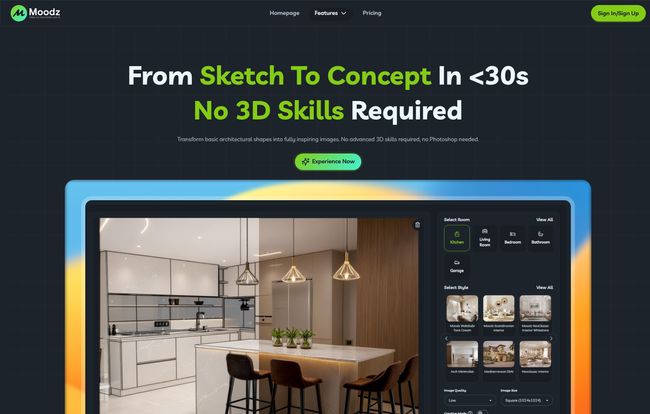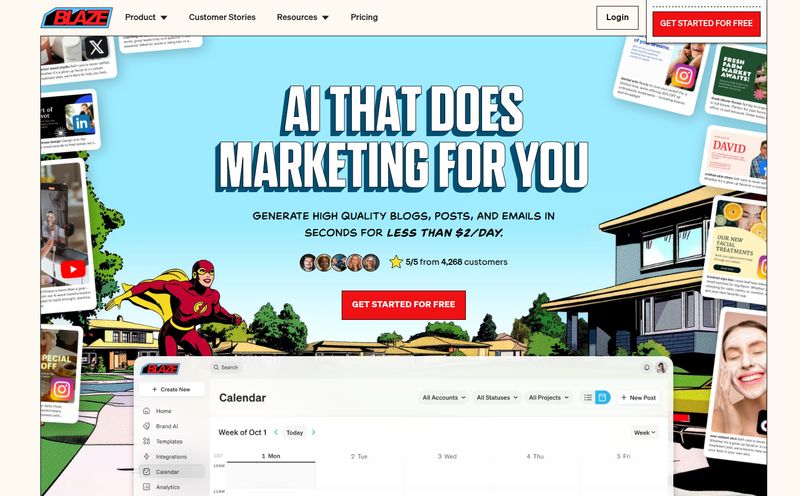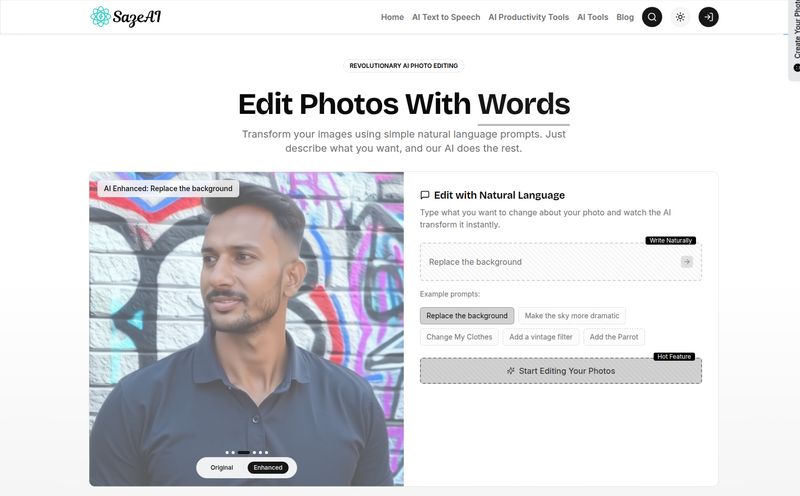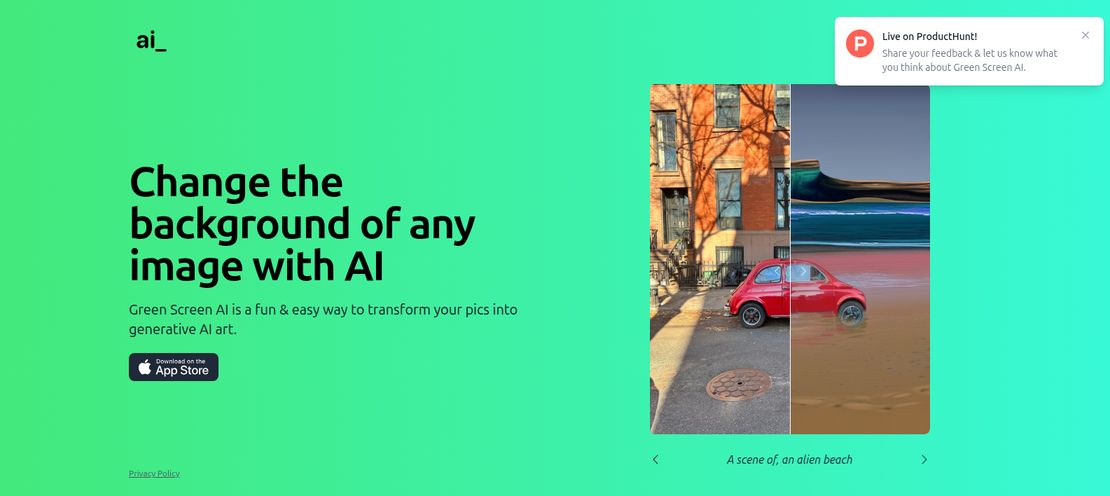If you’re in the architectural or interior design space, you know the grind. The endless hours tweaking a render in V-Ray or Blender, the back-and-forth with clients over the exact shade of beige for the kitchen cabinets, the creative block that hits right before a deadline. It's a process. A long, sometimes painful, process.
For years, we’ve been hearing whispers about AI coming for our jobs. But mostly, it’s felt like a lot of noise. Generic image generators that are fun for making a cat in a spacesuit but fall apart when you ask for something with specific structural integrity. So when I first heard about MoodZ AI, I was skeptical. Another AI tool promising the world? Yawn. But then I saw their tagline: “From Sketch To Concept in <30s.”
Okay, you have my attention.
I've spent my career chasing faster workflows and better ways to get the vision in my head onto the screen for a client. So, I decided to take a proper look. And honestly? I'm kind of impressed.
So What is MoodZ AI, Really?
At its core, MoodZ AI is a specialized AI tool built from the ground up for architects, interior designers, 3D artists, and even enthusiastic homeowners. Think of it less like a Swiss Army knife and more like a perfectly weighted chef's knife. It does one thing—transforming simple sketches or images into stunning, realistic design concepts—and it does it incredibly well.
You upload a basic layout, a sketch, even a photo of a room you want to renovate, and its AI gets to work. Within seconds, it spits out multiple high-quality design options. We're talking different styles, materials, lighting. It’s like brainstorming with a team of hyper-caffeinated designers who all have impeccable taste.
This isn't about replacing the designer's creativity. I see it as a tool to amplify it. It’s for smashing through that initial creative barrier and getting to the good stuff—the refinement, the details, the client collaboration—way faster.

Visit MoodZ AI
Why It's Not Just Another AI Chatbot
Now, some of you are probably thinking, “Can’t I just do this with ChatGPT-4 or Midjourney?” And yes, you could try. You could spend an hour crafting the perfect, convoluted prompt, hoping the AI understands what a “transitional style with wabi-sabi influences and a hint of brutalism” actually means. Good luck with that.
MoodZ AI sidesteps that whole mess. It’s been trained specifically on architectural and design data. It already knows the language. The comparison on their own site is pretty blunt, and I have to say, it’s accurate.
Here’s a quick breakdown of where they differ:
| Feature | Generic AI Chat (e.g., ChatGPT) | MoodZ AI |
|---|---|---|
| Pricing Model | Monthly Subscription Fee | Credit Per Use / Self-Hosting |
| Prompting | Manual, often complex writing | Pre-built, Optimized Prompts |
| Knowledge Base | General, broad knowledge | Optimized for Architecure |
| Workflow | Limited understanding of design stages | Integrated, design-centric workflow |
| User Interface | Generic and text-based | Visual, architect-oriented UI |
What this table tells me is that MoodZ is for professionals who don’t have time to play games. The pre-built prompts and integrated workflow mean you’re working within a system that understands your goals from the get-go. It's the difference between asking a random person for directions and asking a local guide.
The Features That Actually Move the Needle
A tool is only as good as its features, right? Here’s what stood out to me.
From a Doodle to a Dream Room
The main event is obviously the image generation. The ability to take a crude sketch and see it as a photorealistic room is, frankly, magical. This is huge for client presentations. Instead of saying “imagine this wall is green,” you can show them. You can generate five different views from a single sketch, giving a much better sense of the space.
Smart Material Swapping
This is a game-changer. A client wants to see the oak flooring as polished concrete instead? In a traditional workflow, that could mean a whole new render—hours of waiting. With MoodZ, it's a few clicks. This feature alone could save studios so much time and money, reducing the friction of client revisions to almost zero.
The Self-Hosting Option for a Power-User
Okay, this is for the serious studios and freelancers. MoodZ offers a self-hosting option. This means you install the software on your own hardware. It’s a bigger upfront investment and requires some technical know-how. But the payoff? Unlimited image generation. No more buying credits. For a high-volume studio, the lifetime package could pay for itself in a few months. Plus, it gives you more control and privacy over your projects, which is a big deal for some firms working on sensitive designs.
PSD Export — Your Escape Hatch
One of my biggest fears with new platforms is getting locked into their ecosystem. That’s why the PSD file export is so important. MoodZ lets you export your generations as layered Photoshop files. This is brilliant. It means you can use the AI for the heavy lifting—the initial concept and visualization—and then pop the result into Photoshop for fine-tuning, color correction, and adding your own signature touches. It respects the professional workflow, and I love that.
Let’s Talk Turkey: The Pricing Structure
Alright, the money part. MoodZ operates primarily on a credit system for its cloud-based service, with separate plans for self-hosting. Let's be upfront: credit systems aren’t for everyone. They can feel a bit like being at an arcade, constantly feeding tokens into a machine.
The pricing is listed in Vietnamese Dong (₫), which tells me they have a strong focus on the Southeast Asian market, a booming hub for tech and design. Here’s a rough idea of their credit packages:
- Basic (2,490 credits): ~249,000₫
- Pro (6,200 credits): ~599,000₫
- VIP (16,000 credits): ~1,499,000₫
The more you buy, the cheaper each credit gets. It’s a standard volume discount model. For occasional use, the Basic plan is probably fine. For freelancers, the Pro or VIP plans make more sense.
Then there’s the self-hosting, which is a one-time purchase for a set duration:
- 3 Months: 2,000,000₫
- 6 Months: 3,000,000₫
- 1 Year: 5,000,000₫
- Lifetime: 10,000,000₫
That lifetime deal, while a hefty initial cost (roughly $400 USD as of late 2023), is very tempting for a full-time professional or small agency. Do the math on how many projects you do a year, and it could be a massive long-term saving.
The Honest Pros and Cons
No tool is perfect. Let's weigh the good with the not-so-good.
“I’ve seen a lot of AI tools come and go. The ones that stick are the ones that solve a real, nagging problem without creating three new ones. MoodZ feels like it’s on the right track.”
The Good Stuff
The speed is the obvious win. It drastically cuts down the time from initial idea to a presentable concept. It democratizes high-end visualization; you dont need to be a 3D rendering guru to produce beautiful images. The flexibility of the PSD export and the power of the self-hosting option show a real understanding of the professional market.
The Potential Downsides
The credit system will be a dealbreaker for some. It can be hard to budget for, especially when you're in a creative flow and burning through generations. And a big one for me: their policy states no refunds for unused credits or packages. That feels a bit harsh, so be sure you want it before you buy. Finally, the self-hosting option, while powerful, isn't for the faint of heart. You'll need the right hardware and a bit of IT savvy to get it running.
My Final Take: Is MoodZ AI Worth Your Time?
After digging in, my initial skepticism has mostly melted away. MoodZ AI isn't just a toy. It's a sharp, focused tool designed for a specific purpose, and it hits that mark incredibly well. It’s not going to replace skilled architects or designers. What it will do is take over the most tedious, time-consuming parts of their jobs, freeing them up to focus on creativity, client relationships, and building better spaces.
If you’re a freelancer looking to take on more projects without burning out, a student wanting to build a killer portfolio, or a studio aiming to streamline your concept phase, I think you owe it to yourself to check it out. It might just be the most productive new team member you hire this year.
Frequently Asked Questions
- How exactly does the credit system work in MoodZ AI?
- You purchase a package of credits, and each image generation or specific action within the tool consumes a certain number of those credits. The exact cost per action can vary. It's a pay-as-you-go model for their main cloud service.
- Is there any way to get a refund if I don't use my credits?
- According to their policies, no. All purchases of credit packages and self-hosting plans are final and non-refundable. It's important to start with a smaller package if you're unsure.
- Is MoodZ AI difficult for beginners to learn?
- Not at all. The user interface is designed to be intuitive and visual. Since it uses pre-built, optimized prompts for architecture, you don't need to be an 'AI whisperer' to get great results. The learning curve is much gentler than traditional 3D modeling software.
- Who really benefits from the self-hosting option?
- High-volume users. This includes professional 3D artists, architectural firms, and busy interior design studios that produce a large number of concepts and revisions. The upfront cost is higher, but it provides unlimited use, making it more cost-effective in the long run.
- Can I use MoodZ for things other than architecture?
- While it's heavily optimized for architectural and interior design, its powerful image generation could potentially be used for other creative fields like product staging or set design. However, its core strengths and pre-built features are all geared towards the built environment.
Reference and Sources
- MoodZ AI Official Website: https://moodz.ai/
- MoodZ AI Pricing Page: https://moodz.ai/pricing
- Forbes Article on AI in Architecture: How AI Is Reshaping Architecture



